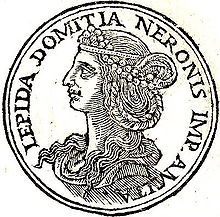
Julia Agrippina, also referred to as Agrippina the Younger, was a Roman empress.

The Julio-Claudian dynasty comprised the first five Roman emperors: Augustus, Tiberius, Caligula, Claudius, and Nero.

Marcus Vipsanius Agrippa was a Roman general, statesman, and architect who was a close friend, son-in-law, and lieutenant to the Roman emperor Augustus. He was responsible for the construction of some of the most notable buildings in history, including the original Pantheon, and is well-known for his important military victories, notably the Battle of Actium in 31 BC against the forces of Mark Antony and Cleopatra.
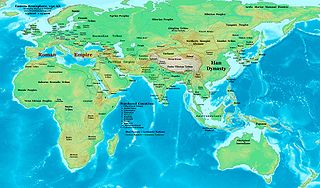
The 50s decade ran from January 1, 50, to December 31, 59. It was the sixth decade in the Anno Domini/Common Era, if the nine-year period from 1 AD to 9 AD is considered as a "decade".
This article concerns the period 19 BC – 10 BC.
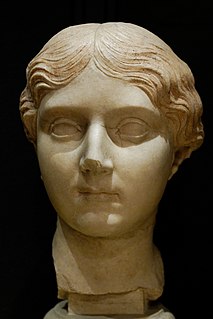
Antonia the Elder was a niece of the first Roman emperor Augustus, being the eldest daughter of Octavia the Younger and her second husband the Triumvir Mark Antony. She married Lucius Domitius Ahenobarbus and became the maternal grandmother of empress Messalina as well as paternal grandmother of the emperor Nero.
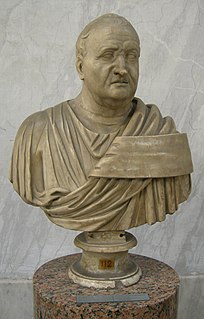
Gnaeus Domitius Ahenobarbus was a member of the imperial Julio-Claudian dynasty of Ancient Rome. Domitius was the son of Antonia Major. He married Agrippina the Younger and became the father of the Emperor Nero.
Aemilia Lepida is the name of several ancient Roman women belonging to the gens Aemilia. The name was given to daughters of men belonging to the Lepidus branch of the Aemilius family. The first Aemilia Lepida to be mentioned by Roman historians was the former fiancée of the younger Cato. Subsequent Aemiliae are known because of their marriages.
Gaius Sallustius Passienus Crispus was a prominent figure in the Roman Empire during the first century. He held the consulship twice, and was stepfather of the future emperor Nero.

Claudia Octavia was an empress of Rome. She was the daughter of the Emperor Claudius and stepsister and first wife of Emperor Nero.
Decimus Haterius Agrippa was a Roman plebeian tribune, praetor and consul. He was the son of the orator and senator Quintus Haterius and his wife Vipsania.

Octavia the Younger was the elder sister of the first Roman Emperor, Augustus, the half-sister of Octavia the Elder, and the fourth wife of Mark Antony. She was also the great-grandmother of the Emperor Caligula and Empress Agrippina the Younger, maternal grandmother of the Emperor Claudius, and paternal great-grandmother and maternal great-great-grandmother of the Emperor Nero.

The Julii Caesares were the most illustrious family of the patrician gens Julia. The family first appears in history during the Second Punic War, when Sextus Julius Caesar was praetor in Sicily. His son, Sextus Julius Caesar, obtained the consulship in 157 BC; but the most famous descendant of this stirps is Gaius Julius Caesar, a general who conquered Gaul and became the undisputed master of Rome following the Civil War. Having been granted dictatorial power by the Roman Senate and instituting a number of political and social reforms, he was assassinated in 44 BC. After overcoming several rivals, Caesar's adopted son and heir, Gaius Julius Caesar Octavianus, was proclaimed Augustus by the senate, inaugurating what became the Julio-Claudian line of Roman emperors.
Vistilia was a Roman matron of the gens Vistilia known by her contemporaries for having seven children by six different husbands; Pliny the Elder was more impressed by the fact most of her pregnancies were remarkably brief. Five of her sons became consuls, her daughter Milonia Caesonia became Roman empress through her marriage to Caligula, and her granddaughter Domitia Longina became empress through her marriage with Domitian. Due to her fertility Vistilia became a byword for prodigious fecundity in antiquity.
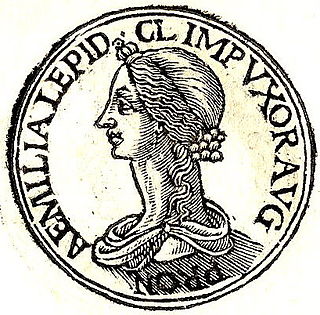
Aemilia Lepida was a noble Roman woman and matron. She was the first great-grandchild of the Emperor Augustus.
The gens Domitia was a plebeian family at ancient Rome. The first of the gens to achieve prominence was Gnaeus Domitius Calvinus, consul in 332 BC. His son, Gnaeus Domitius Calvinus Maximus, was consul in 283, and the first plebeian censor. The family produced several distinguished generals, and towards the end of the Republic, the Domitii were looked upon as one of the most illustrious gentes.
